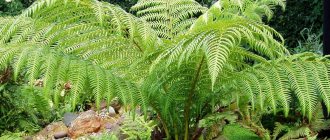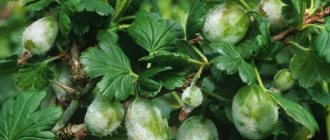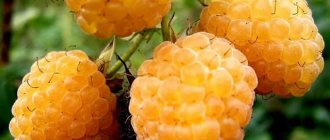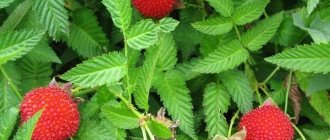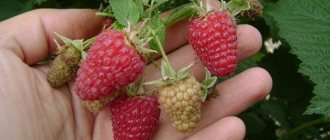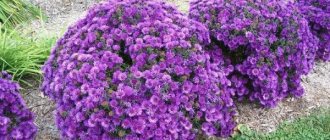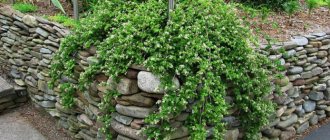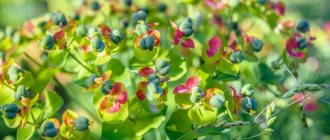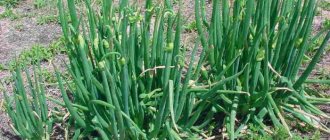Snowberry belongs to the Honeysuckle family. Another name for the plant is Snowberry. You can also sometimes hear it called Wolfberry.
Very often the snowberry is found in parks and squares; it is planted because planting and caring for shrubs in the open ground is not particularly difficult.
Elegant shrubs have been decorating parks for over 200 years.
About 15 species of this unique plant are found in cultivation.
A shrub with white balls, or rather berries, is very fond of birds, who are not averse to eating them. Fruits on the bush can be seen even in winter.
They remain on the bush until the birds peck them completely. Fans of snow berries include waxwings, hazel grouse, and pheasants.
Features and description of the snowberry
Up to 20-300 cm. Whole leaves are planted on underdeveloped petioles, located oppositely. The branches bend well and do not break under thick snow cover in the winter season.
The buds form racemose inflorescences located in the leaf axils. Petals of various shades. Flowering can be observed in the second decade of summer.
After the inflorescences wither, black-lilac round berries appear. They are 2 cm in circumference and have delicate pearly flesh. It is prohibited to eat them; they provoke dyspeptic disorders.
Features of the snowberry
The height of the snowberry can vary from 0.2 to 3 meters. Its entire oppositely arranged leaf plates have a rounded shape and a short petiole, they reach 10–15 mm in length, and have 1 or 2 lobes at the base. The branches do not break under the weight of snow in winter, as they are very flexible. The terminal or axillary racemose inflorescences consist of 5-15 regular flowers of red, white-green or pink color. This shrub blooms in July or August. The fruit is a juicy drupe of spherical or ellipsoidal shape, which reaches 10–20 mm in diameter. The color of the fruit can be purple-black, red, but often white; the seed inside is oval, compressed from the sides. The pulp of these berries looks like shiny granular snow. These berries should not be eaten. This shrub is a good honey plant.
White snowberry is very popular among gardeners, as it is highly resistant to gas and smoke. A hedge made from such shrubs looks especially impressive. This plant with pink berries prefers to grow in regions with mild winters and black soil, while it develops worse in cool climates.
Unpretentious plants for the garden Snezhnoyagodnik. Website "Garden World"
Types and varieties of snowberry
The genus includes 15 species. However, only a few of them are cultivated:
| View | Description | Berries | Height (m) Varieties |
| White (carpal, snow) | The first variety to be included in the genus. Grows in forests, on mountain slopes, along river coastlines. The branches are thin, arched, forming a spherical crown. The leaves are oval, malachite on the outside, bluish on the inside. The flowers are small and pinkish. They grow along the entire stem. Resistant to severe frosts. It has been cultivated since 1879. | They ripen at the same time as the buds. You can watch the entire winter season until the birds peck. | 1,5. The most popular is low shine. |
| Pink (regular) | Can be found in meadows and floodplains. The greenery is emerald green, grayish on the underside. In autumn it acquires a scarlet color. Frost resistance is worse, but it tolerates winters in our country well. | Red, with an ash coating. Scattered throughout the bush. | 2-3.
|
| West | Lives near bodies of water and mountains. The greenery is light malachite, pubescent below. | Crimson or pudding-white, closely fitting to adjacent ones. | 1,5. |
| Mountain-loving | Grows in the west of the North. America. The leaf blades are fleecy. The flowers are single or paired, pinkish or snow-white, in the form of bells. | Whitish two-seeded drupe. | |
| Soft | With creeping shoots. The petals are bright: pudding or amaranth. | Large, pearly. | |
| small-leaved | Homeland: Mexico, New Mexico, Guatemala. Stems with dense pile. The greens are dark emerald green, lighter. It comes with or without lint. | White with a crimson sheen. | 3. |
| Chenault | Hybrid form. Does not tolerate frost. Greenery appears in early spring and does not fall until late autumn. | From snowy to purple. | 1,5. The most popular is Hancock. |
| Dorenboza | Hybrids, named after the breeder who bred them - Dorenboz. This is a cross between the white snowberry and the common snowberry. Flowers are densely planted throughout the bush. | Various tones. | Up to 1.5.
|
Description and characteristics of the snowberry
Pink snowberry is called ordinary or round.
External features of the plant:
- deciduous perennial;
- bush height – up to 2 meters;
- thin flexible branches in young plants grow straight, in old ones they are lowered;
- bark grey-brown, smooth;
- leaves on petioles grow from 1.5 to 6 centimeters long, oval in shape, sometimes with notches along the edges;
- the snowberry leaf is green on the outside and dark gray-green on the back;
- clusters of inflorescences are formed in the axils between the leaves and the stem along its entire length;
- flowers are small, pink;
- the berries are smooth, shiny, round, 1 centimeter in diameter;
- The berry ripens up to 3 seeds.
Mature plants form dense spreading crowns, so they are thinned out in late autumn or early spring.
Pink snowberry blooms from mid-July. The berries are colored in coral, purple shades and remain on the branches after the leaves fall in the fall. Dark bushes with bright bunches of berries decorate gardens and parks in winter.
Planting snowberries in open ground
The tree grows in the sun or in sparse partial shade, on flat terrain or a slope. The substrate can be moist or dry.
Planting takes place in May or September-October. When planting in spring, the soil is prepared closer to winter, before snow falls. In autumn - about 30 days before placing in the soil mixture in the garden.
Step by step steps:
- Dig up the area, adding 1 cup limestone flour, 3 tbsp ash from burnt wood, 2 tbsp superphosphate. The dosage is indicated for one bush.
- 30 minutes before planting, place the underground part in a mixture of water, clay and mullein so that it is saturated with moisture.
- Dig holes with a depth of 0.4 m, a circumference of 0.5-0.6 m, leaving a gap of 1.2-1.5 m.
- Pour sand, peat, humus, compost and additives that were used for digging on the bottom.
- Place the seedlings in the center so that after the substrate settles, the root collar is above the ground.
- Compact the earth so that no voids arise. They will lead to drying out of the roots.
- Water generously.
When planting a hedge, dig grooves 60 cm deep and 40 cm long. The bushes must be four years old, they must be placed on the same horizontal line (for example, along a stretched thread) at a distance of 20-25 cm.
How to properly grow ornamental crops
Planting a snowberry does not require special knowledge or skills. Beginner gardeners can grow an unpretentious, parasite-resistant shrub.
When to plant in the ground
Snowberry is planted in spring, autumn, and less often in summer. In dry weather, bushes require more careful care - abundant watering and loosening.
See also
Description of varieties of Nepalese cinquefoil, application in landscape designRead
Location
The plant tolerates shade and sun well. The roots of the bushes strengthen the soil of loose slopes. Pink snowberry will grow in depleted soil if you add fertilizer when planting and feed it throughout the year. Soil with neutral and low acidity is best suited for bushes.
Preparation of seedlings
Young bushes with bare roots are dipped into a clay mash before planting for quick adaptation. The seedlings are taken out of the boxes with a lump of earth and lowered into the planting hole without shaking it off.
How to plant
For a single bush, dig a hole with a diameter of 50 and a depth of 60 centimeters. A trench of the same depth and width of 0.5 meters is prepared for the hedge. The distance between individual bushes is 150 centimeters. There are 4-5 plants per linear meter of trench.
A drainage 10 centimeters thick is placed at the bottom of the hole or trench, and then a soil mixture of equal parts of river sand, compost and peat is added. Mix for one bush:
- dolomite flour - 200 grams;
- superphosphate - 200 grams;
- wood ash - 600 grams.
For bare-rooted seedlings, the site is prepared six months before planting so that the soil is evenly saturated with fertilizers and subsides. Planting of young bushes with a root ball of soil is carried out at any time of the year, and the soil is prepared 2 weeks before.
The bush is lowered into the hole and covered with soil, leaving the root part of the stem on the surface. Then the plant is watered. The wet soil will subside and the stem will droop.
For 5 days after planting, the snowberry needs daily watering. 4 liters of water are poured under the bush.
Caring for snowberries in the garden
Planting and caring for shrubs is quite simple. The most important thing is to follow these recommendations:
| Factor | Description |
| Watering | The first few days every day. Then there is enough natural precipitation. In dry weather, water using 10-15 liters of water for each specimen. To retain moisture longer, mulch the bushes with peat. |
| Loosening | Apply after precipitation and every time the soil is moistened. Pull out weeds in the process. |
| Top dressing | In spring, apply mineral or organic fertilizers. In mid-summer, pour in Agricola solution (2 heaped tablespoons per 10 liters of water). |
| Picking | Perform only in emergency cases. For example, with strong growth of the root system or infection of the soil. During the process you need to be very careful not to damage the rhizome. In adult specimens it is extensive, so you need to start digging away from the main trunk so as not to touch the roots. |
| A haircut | Produce in the spring before the sap begins to move along the stems and leaves. It is necessary to remove dried and broken branches, and shorten shoots growing in the wrong direction. Treat the cut areas with garden varnish to prevent infection. Anti-aging pruning is done at a level of 50-60 cm from the ground. Thanks to this, new shoots will grow throughout the summer. Pruning does not affect flowering, because... flowering buds are located on the branches of the current year. |
| Other care | At the end of the growing season, dig up the area with the snowberry. |
How to properly care
Transfer to a new place
Snowberry grows a very powerful root system over time. It is recommended to carefully consider the location on the site for this shrub.
If, nevertheless, you have to replant it for some reason, it is better to do it quickly, while the roots have not yet penetrated too deep into the soil.
The snowberry tolerates transplantation well.
The main thing is to damage the root system as little as possible when digging up the plant.
You will have to dig up the bush in a circle at a distance of at least 70 cm from the trunk.
Formation and pruning of the bush
The formation of the bush is carried out before the start of sap flow. This is done immediately after the snow melts. It is necessary to remove dry twigs, damaged branches, and also thin out dense growth.
The unpretentious plant will hardly notice pruning; it tolerates it well.
While the shrub is still young, it is recommended to do pruning more often to create a shrub rather than a tree.
After the procedure, the sections must be treated with garden varnish.
Sometimes rejuvenating pruning is required.
It represents pruning onto a stump. All branches are trimmed, leaving 50 cm above the ground.
The results of pruning can be observed already this season, when young shoots cover the bush.
Snowberry diseases, pests
Snowberry is rarely susceptible to disease. Fungal diseases occur most often in plants.
Snowberry is rarely affected by it, but at the first signs it is necessary to treat the cut with fungicides. The most effective will be Fundazol, Skor, Topaz.
For prevention, it is recommended to treat the snowberry with Bordeaux mixture in early spring.
Pests also rarely attack snow berries. Sometimes pests such as aphids can be seen on the plant. They attack most often in May.
Ashes, which should be sprinkled on the bushes before the rain, will help cope with aphids. The rain will wash away the aphids along with the ash. If this procedure does not bring results, it is necessary to treat with fungicides.
Reproduction of snowberry
Can be propagated by seeds and vegetatively.
Seeds
This growing method is rarely used, because it is long and laborious. Preparation:
- Remove fiber from seeds.
- Fold in nylon cloth and squeeze.
- Pour into a bowl of water.
- Mix well.
- Wait until the seed settles and the remaining pulp floats to the surface.
- Remove the seeds and dry.
Sowing is done in late autumn. This is done not in open ground, but in containers for seedlings. Step by step landing:
- Fill the container with sand, humus, peat, mixed in equal parts.
- Distribute the seeds evenly and sprinkle with a thin layer of sand.
- Cover with film. It must be removed daily for spraying through a spray bottle with a fine nozzle, ventilation and collecting condensation from the walls. Bottom watering can also be done.
- The first shoots can be observed in the spring. Indoor seedlings are transplanted outside at the end of the growing season.
Root shoots
The shrub produces many offspring that form dense clumps. Therefore, the snowberry quickly grows in width and can move.
This method is the simplest. It is enough to separate the well-formed clump and replant it. This will help not only to obtain new specimens, but also to prevent excessive planting density.
By division
This method is used in the spring before the sap begins to move in the shoots or in the fall after the leaves fall:
- Dig up and divide the rhizome into several lobes. Each of them must have a developed root system and strong shoots.
- Treat the cut areas with charcoal.
- Plant cuttings in the garden.
By layering
Step by step reproduction:
- Select a healthy, well-formed branch growing closer to the base.
- Dig a trench in the ground, place a branch there and secure with staples.
- Cover with soil, leaving the top on the surface.
- During the summer, care for it as for a regular shrub.
- In the fall, when the cuttings have formed roots, separate them from the main bush and replant them where it was planned.
Cuttings
Already hardened or green cuttings are suitable for propagation. In the first case, the harvesting is done before or after the growing season. Shoots should be 10-20 cm, with 3-5 shoot primordia. Before planting, young branches are stored in sand in a cool room.
Harvesting green cuttings is done at dawn in early June. Shoots should be long and developed. It is quite easy to determine whether the shoot is ready for planting: you need to bend it. When the branch breaks and crunches, it means the cutting is ripe. The workpieces must be immediately placed in water.
Step-by-step propagation by cuttings:
- Fill the boxes with the same mixture as when sowing the seeds.
- Deepen the branches by 5 mm.
- Place the container in greenhouse or greenhouse conditions (high air temperature and moderate substrate humidity are required for the formation of the root system).
- In the fall, the roots will be ready to be transplanted into the garden.
- For the winter, you need to cover young bushes with spruce branches or dried leaves to prevent freezing.
How to propagate
There are several ways to grow a snowberry plant on your site, depending on the availability of planting material: seeds, cuttings, layering, root shoots, cuttings. The seed method does not guarantee the preservation of varietal differences, and when propagated by cuttings, hybrid characteristics are preserved.
Seeds - harvesting, planting
To harvest seed material, you need to wait until the fruit is completely ripe. Squeeze out the seeds by hand, add water, stir to separate from the pulp. Change the water if necessary. When the peeled seeds settle, drain the water and dry on a cloth.
On a note! It is not recommended to sow on a ridge, because small seeds are pulled into the ground or washed away when the snow melts, so they use the seedling method.
Any container from which it is convenient to remove seedlings is suitable for growing seedlings. The soil mixture is loose and light, for example, peat, sand and humus in equal parts. The seeds, evenly scattered over moist soil, are lightly sprinkled with a thin layer of sand and covered with film or glass.
The container is placed in a room where the temperature is not higher than +5 °C. The soil must be moistened occasionally with a spray bottle. By spring, the first shoots should appear, when 2-3 leaves have formed on them, plant them in open ground. The first flowers will appear in three years.
Cuttings
The snowberry variety you like can be propagated by cuttings, preserving the varietal characteristics. Green and woody cuttings are suitable. Woody trees are cut in the fall, when frosts begin. To do this, the mature shoot is slightly bent - if it is broken, it means it is ready for use.
The top of it is cut off so that a segment 15-20 cm long with 3-4 buds remains. From below, under the bud, an oblique cut is made to increase the area of wood in contact with the soil. The cuttings are planted in containers (soil mixture as for sowing seeds), deepened by 4-5 cm, so that half of the buds are in the ground, half on top.
At the beginning of June, the green young shoot is cut off and immediately planted in damp soil in a greenhouse or greenhouse. By autumn it will take root and can be transplanted to a permanent place, covered with leaves and grass for the winter.
Root shoots, layering, divisions
A lot of root shoots form around the bush, and it is easy to dig up the required number of shoots. They must be immediately planted in the prepared holes and watered.
Propagation by layering is also simple - dig a shallow trench, bend a young branch, cover a small area with soil, water it, loosen the soil nearby. When the branch gives roots, use a shovel to cut off the cuttings with roots and plant them in a permanent place.
Dividing an adult bush with overgrown roots into smaller parts is difficult, but possible. Treat the sections with coal powder and plant the cuttings in prepared holes with the addition of fertilizers.
Diseases and pests
Since wolfberry is a poisonous plant, it is not affected by insect pests. It is also resistant to various infections. In rare cases, with poor care, infection with ashtray and gray mold can occur. To save the bush, it is necessary to use chemicals: Strobi, Falcon, Maxim, Skor, etc. Traditional methods (for example, wiping with a soap or alcohol solution) will not help.
To prevent diseases in early spring, bushes should be treated with Bordeaux mixture 3%. This will reduce the likelihood of fungal development.
Flower care
The snowberry grows well and bears fruit if the bush is watered moderately, fed twice a year and pruned.
Fertilizers and fertilizers
The first fertilizing is applied in mid-April. The soil is dug up with humus. One bush requires 6 kilograms of organic fertilizer, to which 100 grams of potassium salt and superphosphate are added. Before flowering in July and August, plants are fertilized with Agricola. 50 grams of fertilizer are dissolved in 10 liters of water and poured under one bush.
Watering, loosening, fertilizing
The snowberry plant does not need to be watered frequently. In rainy weather, the plants will do without watering. In hot weather, one bush requires 15-20 liters of water. After watering and rain, the soil needs to be loosened.
Mulching will help retain moisture in the soil and not have to worry about loosening. The tree trunk circle is covered with a layer of peat 8-10 centimeters thick. In the fall, the soil is dug up.
Trimming
In spring, branches damaged by frost are removed. At the end of May, beginning of June, the bushes are given a decorative shape. Trimming is carried out before flowering begins, so that inflorescences form on the trimmed branches. Without pruning, the bushes thicken and bloom poorly.
See also
Description of catharanthus varieties, propagation, cultivation and care in open groundRead
Mr. Summer Resident recommends: medicinal properties of snowberry
Wolfberry is poisonous, but only in large quantities. Using small doses helps with:
- wounds, cracks on the hands (fresh berries);
- various skin lesions and ulcers (mush from leaves);
- tuberculosis, venereal diseases (bark decoction).
The healing properties of snowberry have not been fully studied, so any non-traditional method of therapy should be agreed upon with a doctor. Otherwise, you can cause serious harm to your health. In addition, folk remedies can only alleviate the pathological condition, and not cure it completely.
To avoid undesirable consequences, wolfberry should not be planted on the territory of preschool institutions, schools, or playgrounds. Children are very curious; they can taste the fruit and get poisoned. The main symptoms of intoxication will be vomiting, nausea, poor health, indigestion, and diarrhea. In this situation, you need to immediately perform a gastric lavage and call an ambulance.
Wolfberry is a very beautiful ornamental shrub that will adorn any landscape design. It is unpretentious to living conditions, resistant to diseases and pests, and tolerates polluted atmospheres well. Therefore, the plant can be used for urban landscaping, planted near factories and highways.
Snowberry garden in territory design
The plant is distinguished not only by its unpretentiousness, ease of planting and care, but also by its good tolerance of polluted city air, which is why snowberry is successfully used in park plantings, landscaping industrial areas, and roads.
Possible uses:
- can be planted as a ground cover under large trees, as a plant that strengthens soil on crumbling slopes;
- low-growing varieties are suitable for rock gardens and ridges;
- any variety looks great together with a climbing rose in a decorative hedge;
- rowan and snowberry growing nearby create a contrasting spot on the site;
- bushes with white berries against the background of coniferous trees look bright and original.
Snowberry: planting, care, reproduction
The cut areas are lubricated with garden varnish. The snowberry needs sanitary pruning; after trimming the dried and broken branches, the whole plant is well restored. On older bushes, small leaves and flowers, weak and short shoots develop. Since the snowberry produces root shoots and actively regenerates from the lower and middle parts of the bush, it tolerates rejuvenating pruning well.
The snowberry is almost not damaged by diseases and pests. The greatest danger is posed by fungal diseases: powdery mildew and gray rot of fruits, which actively develop in humid conditions. Spraying is carried out in the spring before the buds open.
Snowberry can be propagated by root shoots, cuttings, layering, dividing the bush and seeds. Root shoots Snezhnoyagodnik produces abundant root shoots, due to which large dense clumps are formed, and the bush is able to expand, moving from the planting site.
You need to monitor this, dig up the shoots in time, or use them for propagation. In early spring or autumn, you can easily propagate snowberry by root shoots and at the same time save the bush from thickening. By dividing the bush In early spring or autumn, during the period of leaf fall, a heavily overgrown snowberry bush is dug up and divided into parts along with the root system.
Layerings Snowberry layerings are obtained by hilling the bush with earth. You can also take the shoots into a specially prepared ditch and pin them with soft wire. The buried shoots begin to take root, and by the end of the growing season an independent bush with a powerful root system develops.
The plant is pruned with pruning shears and transplanted to a permanent location. Snowberry is also propagated by cuttings. Stem cuttings are taken woody in winter and green in summer.
Snowberry - a shrub with an easy-going character
Lignified cuttings are harvested in late autumn or early winter and stored in sand in basements. In spring, cut into cuttings cm long with 3 or 5 buds. The upper cut is made above the kidney, the lower one - obliquely. Green cuttings are cut from the bush in the first half of June, when the plants fade. Only large, well-developed shoots in a mature state are suitable for cuttings; For cutting cuttings, young shoots are selected from bushes no older than 10 years. How to determine the suitability of a shoot for cuttings?
When bent, the shoot should break with a crunch; if it is softer or very lignified and does not bend well, then it is unsuitable for green cuttings. The shoots are harvested early in the morning and immediately placed in a container of water. In cool weather, cuttings are cut, preferably in the shade, into cm-long pieces with 2 internodes; large leaf blades are cut in half.
To accelerate root formation, the cuttings are placed in a solution of the growth stimulator heteroauxin, which is prepared from 1 tablet of the substance and 1 liter of water, or sprinkled with powdered Kornevin.
Green and lignified cuttings are planted in boxes with nutritious soil, half mixed with river sand. Planting depth is 0.5 cm. And do not forget, after dividing the bush, to treat the cuts on the roots with crushed coal.
In early spring, bend a low-growing young branch, place it in a groove made in advance in the soil, secure it in this position and cover it with soil, leaving the top above the soil surface. Take care of the layer all summer: water it along with the bush, fertilize it, loosen the soil around it.
In the fall, the rooted cuttings are separated from the mother plant with pruning shears and transplanted to a permanent place. Snowberry can be propagated by green and woody cuttings. Lignified cm-long pieces with buds are harvested in late autumn or early winter and stored until spring in the basement, placed in sand. You need to cut the top edge above the kidney, and the bottom edge obliquely. Green cuttings are harvested early in the morning, at the beginning of summer, as soon as the snowberry flowering has ended.
You need to cut off large, well-developed and mature shoots. Determining whether a shoot is mature enough for propagation by cuttings is very simple: it is bent, and if the shoot breaks with a crunch, this confirms its maturity.
After cutting, the cuttings are immediately placed in a container of water. Green or lignified cuttings are planted in boxes with a substrate of the same composition as for seed propagation. Planting depth is no more than 5 mm. The box with cuttings is placed in a greenhouse or greenhouse and rooted in conditions of high air humidity and moderate substrate humidity.
By autumn, the cuttings will have acquired a stable root system, and they are transplanted into the ground, covered with leaves and spruce branches for the winter. But even if the plant freezes in severe frosts, it will completely recover during the growing season. It is advisable to cover young bushes high in soil for the winter. As you probably already understood, planting a snowberry and caring for it will not take you much time and effort, but its extraordinary fruits will decorate your garden and feed birds almost all winter.
The most famous species of the genus is the white snowberry, also known as the white snowberry, which grows naturally on open slopes, along river banks and in mountain forests of North America from the west coast to Pennsylvania.
The height of the white snowberry reaches one and a half meters. This is a deciduous shrub with thin shoots and a rounded crown. The leaf of this species is ovoid or round, simple, notched-lobed or entire, up to 6 cm long, green on the upper side of the leaf blade and bluish on the bottom. Small, soft pink flowers are collected in dense racemose inflorescences located along the length of the entire shoot. The flowering is abundant and so long that at the same time you can see both buds and fruits on the bush - white, elegant and juicy spherical berries up to 1 cm in diameter, which stay on the bush for a very long time.
Listen to the article
The winter hardiness of the snowberry is as high as its unpretentiousness to growing conditions. This species has been in cultivation for a year, most often it is used for group plantings, hedges and borders. Our readers ask: is the white snowberry poisonous or not? Its fruits are inedible, and the substances they contain can cause dizziness, weakness and vomiting.
An attractive variety for gardeners is the white snowberry variety Symphoricarpos albus var. It grows in North America in meadows or along river banks and is a large shrub with thin shoots and small dark green leaves with a bluish underside.
Growing
Its pink flowers, like those of white snowberry, are collected in short, dense inflorescences. The plant is very beautiful in the fall, when coral or purple-red hemispherical fruits, covered with a bluish coating, begin to ripen along the entire length of the shoots, and the leaves acquire a purple tint. This type of snowberry is not as winter-hardy as the white one, but its resistance to cold is quite sufficient for wintering in the middle zone.
Common snowberry is very popular in Western Europe, especially its varieties Variegatus with an uneven yellowish stripe along the edges of the leaves and Tuffs Silver Age with a white border.
From the eastern, western and central regions of North America, where it forms thickets along rivers, streams and on rocky slopes.
The plant reaches a height of one and a half meters. The leaves are soft green on the upper side and felt-like pubescence on the lower side. The flowering of white or soft pink bell-shaped flowers, collected in dense and short racemes, continues from early June to late August, gradually giving way to the appearance of soft, almost spherical berries of a pale pink or white hue.
From the western part of North America it grows up to one and a half meters in height. Its leaves are oval or rounded, with slight pubescence. Flowers are paired or single, pink or white, bell-shaped. The fruits are white, spherical, with two seeds. Winter hardiness is average. A hybrid descendant of the common snowberry, or rounded one, and the small-leaved snowberry, characterized by short stature, dense pubescence, sharp leaves up to 2.5 cm long and pink berries with white cheeks.
Unfortunately, this hybrid is not frost-resistant. Hybrid shrub up to 1.5 m high and the same crown diameter. The leaves are rich dark green on the top and gray on the bottom, open early and fall late, pink flowers are collected in inflorescences, rounded fruits ranging in color from white to purple do not fall from the bush for a long time. The best variety of this species is snowberry Hancock.
Combines a group of hybrid varieties bred by the Dutchman Doorenbos by crossing white snowberry with rounded snowberry and characterized by compactness and abundance of fruits:. In addition to the described species, Chinese, round-leaved, soft, small-leaved and Mexican snowberries are known.
Name required.
Description of the plant
Find out how to preserve poinsettia after flowering here. See how to grow cyclamen here. Contents Listen to the article Description Planting snowberry in open ground When to plant How to plant Caring for snowberry in the garden How to grow Replanting snowberry in the garden Cutting snowberry Pests and diseases Reproduction of snowberry Seed propagation Reproduction by root shoots Dividing a snowberry bush Reproduction by layering Reproduction of snowberry by cuttings Snowberry after flowering Types and varieties snowberry
Listen to the article. Planting and caring for snowberries Planting: in spring and autumn. Flowering: from July or August. Lighting: bright light or partial shade. Soil: any, including rocky and calcareous. Watering: only during drought, in the evening, at a flow rate of 1, buckets of water under each bush. Top dressing: in early spring, kg of humus or compost, g of potassium salt and the same amount of superphosphate are added to the root area. In mid-summer, if necessary, the bush is fed with a solution of 50 g of Agricola in 10 liters of water.
Pruning: in early spring, before the start of sap flow, sanitary and formative pruning is carried out.
Reproduction: by root shoots, dividing the bush, layering, cuttings, less often by seeds. Pests: do not affect. Diseases: powdery mildew and gray rot of fruits. Properties: the plant is poisonous. Mirabilis: planting and care in the garden, growing from seeds. Adonis: planting and care in open ground. Lupine: planting and care, growing from seeds. Skumpia: medicinal properties and contraindications Skumpia: planting and care, types and varieties. Comments Elena Zhukova ElenaN The flowers of this plant secrete nectar for 40 days, and the snowberry blooms from late July to late autumn, and bees collect nectar even in rainy weather.
Plant propagation
You can get new plants either by seeds or by using vegetative propagation methods. Propagation of snowberries by seeds takes a lot of time and does not always give results, so it is used only in extreme cases.
Using seeds
First you need to prepare the seeds for the procedure. To do this, the berries of the plant are crushed in a nylon stocking or gauze, the seeds are taken out of them and soaked in water to remove the pulp. After which they should be dried and only then should planting begin.
Seeds are planted both in autumn and spring. Autumn planting is preferable, since during the winter the seeds undergo natural stratification, which increases germination. Snowberry seeds are small, so it is better to plant them in boxes. Otherwise, when the snow melts, they may sink too deeply into the soil and not rise. During autumn planting, seedlings appear earlier, and they can be planted at the end of spring.
In the spring, the seeds are planted in boxes that are placed in the greenhouse. They take longer to germinate and are planted only in June. To speed up germination, you can carry out stratification by placing the seeds in a damp mixture of peat and sand, which is placed in the refrigerator for the entire winter period.
A shrub planted with seeds usually blooms only in the third year. Therefore, those who want to get strong plants earlier should resort to other propagation methods.
Vegetative methods
This is an easier way of reproduction. All of his methods are quite simple, and even an inexperienced gardener can use them. These include options such as:
- Planting root shoots. Snowberry belongs to the crops that form numerous root shoots. It can serve as an excellent planting material. All you need to do is carefully dig out the required number of shoots and plant them in a previously prepared place;
- Reproduction by layering. It is very easy to get layering. You just need to bend a young twig to the ground and sprinkle the junction with the soil with a layer of soil. When it gives roots, it is cut off from the main plant with pruning shears, dug up and planted;
- Using cuttings. Cuttings are harvested in autumn or summer. Their length can be 10−20 cm. When harvesting material in the fall, it will need to be stored until spring in a cellar or other cool place, placed in boxes with wet sand. Such cuttings are planted in early spring. With the summer harvesting method, you need to wait for the end of flowering and select ripe shoots. Such cuttings are planted in containers with a mixture of sand and peat and placed in a warm, damp place. After rooting, they are planted in the ground. This usually happens in the fall. Such plantings are covered with foliage in winter to protect them from frost;
- Dividing the bush. To divide a bush, you need to dig it up, which is not very easy. Therefore, this method is not very common. After digging, the bush is divided into several parts, and the damaged areas are treated with coal. After this, each part sits in a pre-prepared hole.
The snowberry will take root in any area and will serve as an excellent decoration all year round. It will make an excellent hedge that does not require complex care. And the description of its decorative properties cannot be compared with how great it looks in reality.
Post navigation
Currently, it has become popular to plant ornamental shrubs in summer cottages, creating beautiful flower arrangements. Among the ornamental bushes, you can often find the amazing snowberry bush, strewn with snow-white berries. The compact bush easily fits into any composition and is an excellent decoration for any garden. This unpretentious plant delights with lush flowering in summer and white clusters of berries in autumn. Every summer resident can grow this unusual plant on his property. Snowberry planting , cultivation and care will not cause any difficulties even for a novice gardener.
snowberry planting
Characteristics of the snowberry
The bush reaches a height of up to 1.5 m and has an oval-spherical shape. The plant is unpretentious and easily tolerates adverse weather conditions. It is frost-resistant, drought-resistant, and can grow in the shade, although it grows faster and more luxuriantly in a sunny location. The soil doesn't matter much. However, a luxurious bush can be obtained on fertile, slightly alkaline or neutral soil. The bush blooms with pink flowers in summer, and fruits appear in September.
The bush easily tolerates pruning, which allows you to give it its original shape.
Types of shrubs
It belongs to the honeysuckle family and there are more than 15 varieties. Among these species there are varieties not only with white berries, but also with pink ones.
- One popular shrub is white snowberry , whose thin branches hang down to the ground, forming a bluish-green hemisphere. Bell-shaped pink flowers are formed in the axils of the leaves, especially at the tips of the branches. The bush blooms from July to September, large fruits up to 1 cm begin to appear in August - September and remain on the branches in winter. This type of snowberry is very unpretentious, winter-hardy and grows well even in the shade on any soil.
- Purple snowberry is named for the color of its fruit. The plant does not tolerate frost as well, but it is quite possible to grow this species in our country. There are varieties of this variety with yellow and white leaf edges.
- A well-distributed hybrid of the Chenault round pink snowberry. This bush is small in size, the flowers are fragrant, excellent honey plants, the fruits cannot be eaten. Long shoots take root easily.
- The Doorenboza variety is rightfully considered more beautiful . This variety is decorative, but less resistant to frost and should be covered for the winter.
Landing place
To grow luxurious bushes, it is better to plant them in fertile soil and a sunny place, although the plant does well in the shade. Acidic soil must be treated with chalk, lime or dolomite flour before planting.
Planting a snowberry
Dig up the chosen place well, add humus. Make a planting hole with a diameter and depth of 0.5-0.6 m and plant the bush without shaking off the soil from the roots. Cover the seedling with a mixture of humus, sand, peat, superphosphate, wood ash and dolomite flour.
If you decide to use decorative bushes as a hedge, then dig a trench 0.4-0.5 m wide and up to 0.6 m deep and plant the plants every meter.
snowberry care
Shrub propagation
It can be done by dividing the bush , cuttings or layering. An adult plant produces a lot of root shoots, which can be replanted in spring or autumn. Or dig up an adult plant and divide it into separate parts.
When propagating by layering in the spring, the lower branches are dug into the grooves, pinned with wire and sprinkled with earth. With regular watering, by autumn you can get a separate plant with a well-developed root system.
Propagation by cuttings allows you to grow many bushes from one plant. Green cuttings are cut in June, which are planted obliquely in the garden bed, covered with cut plastic bottles and protected from the sun. The plantings are regularly watered and by autumn the cuttings have formed a good root system.
Snowberry care
Growing shrubs is not difficult to accomplish. Periodic loosening, weeding, and watering are required, which is best done in the evening, pouring up to 25 liters of water under an adult plant.
Fertilizing should be done twice a season, using berry fertilizers (50 g of Agrico per bucket).
Pruning to form a bush is best done in the spring before the buds open. Do not prune new shoots, otherwise the bush will not bloom. Typically, pruning is done at ¼ length or half. But to rejuvenate the plant, it is cut to fit the stump, leaving a height of no more than 0.6 m.
We hope our useful tips will help you. An unpretentious snowberry, its planting , cultivation, and care do not cause complications. It is able to grow in soils where other plants do not take root. The amazing decorativeness of the snowberry attracts summer residents every year.
If you find an error, please select a piece of text and press Ctrl+Enter.
Share with your friends on social networks!
I invite you to the group on Subscribe.ru for summer residents and gardeners: “Country Hobbies” All about country life: cottage, garden, vegetable garden, flowers, recreation, fishing, hunting, tourism, nature
Description of the plant
Snowberry, also known as snowberry or wolfberry, is a shrub from the Honeysuckle family. Its height ranges from 0.2 to 3 m. North America is considered to be the birthplace of this plant.
The height and color of snowberry fruits depend on its variety. The berries can be white, pink or deep red. It is also worth considering that each variety has an individual degree of winter hardiness. That is why not all of its varieties managed to take root in Russia.
White snowberry can boast excellent resistance to harsh climatic conditions. We will talk about this plant today. The shrub is densely covered with foliage. Its maximum height is 1.5 m. It has small dark green leaves and flexible stems that can withstand a load in the form of snow cover. The flowers are white or light pink.
Snowberry blooms in mid-July. The flowering period lasts until the end of August. In early September, snow-white fruits can be found in place of the inflorescences. It is at this time that the bush looks especially impressive. The diameter of the berries can be about 1 cm. They form strong clusters.
The shrub is in great demand among landscape designers. Often decorates city parks and squares. Even in such conditions, the plant is able to fully develop and bestow its beauty. It adapts to unfavorable environmental factors; it only needs rain watering and infertile soil. As for growing on private property, in such conditions the snowberry can change beyond recognition.
If you provide the plant with proper care, it will give good growth every year, delight you with dense foliage of bright color and an abundance of white berries. This gorgeous plant can act as a hedge. It can also be included in a composition of various ornamental crops. Please note that snowberry fruits are poisonous. Snow-white berries look appetizing, so they can attract the attention of children. To avoid sad consequences, it is advisable to have a green pet only after the children have matured.
Snowberry with pink fruits. Photo from lostintheflowers.com
The best places to plant snowberries
The shrub feels great both in the shade and in the sun, withstands long-term drought, and is not afraid of even severe frosts. That is why the snowberry grower can decorate areas where nothing is accepted. But nevertheless, gardeners noted that the most luxurious bushes grow on fertile soils. Snowberry thrives in the sun; it loves soil with a neutral reaction, or at least slightly alkaline. Therefore, if you want to grow a beautiful bush, you should listen to the above recommendations.
